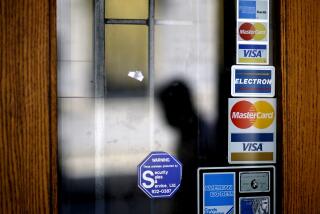U.S. household debt keeps shrinking
- Share via
Reporting from New York — The debts of American households shrank for a seventh straight quarter, the Federal Reserve said Tuesday in a new report documenting how the easy-money boom has given way to a powerful contraction in borrowing.
Total household debt has tumbled 6.5% from its peak in 2008, reflecting a retrenchment that has been both voluntary and involuntary.
Credit card balances, for example, have declined in the last two years, but lenders slashed card limits even more sharply.
Although the decline in indebtedness has improved Americans’ personal balance sheets overall, it also has contributed to weak consumer spending, putting a drag on the economic recovery. And the debt reduction is unlikely to end soon, said Paul Ashworth, senior U.S. economist at research firm Capital Economics.
“It took 20 years for households to become so leveraged, so it won’t just be fixed in a year or two,” he said. “We’re still in the early stages of an adjustment.”
The new data, compiled by the Federal Reserve Bank of New York, show consumers are still struggling to pay off the big debts they amassed in the freewheeling years before the credit crisis: The number of new personal bankruptcies surged 34% in the second quarter, much more than a typical seasonal second-quarter decline of about 20%. New foreclosures increased 8.7%.
The nationwide delinquency rate fell in the second quarter, marking the first decline since 2006, but the rate of serious delinquency — bills more than 90 days late — went up.
Because mortgages account for most household debt, California led the nation with the highest amount of debt outstanding per person: $77,500, down 2.3% from the first quarter and 12% from early 2008.
Of the 11 states that the study broke out individually, Ohio had the lowest debt per capita, slightly less than $40,000. The national average was $48,800.
The percentage of California households more than 90 days late in paying their bills, 11.5, was greater than the national average but below that of Nevada and Florida.
Although consumers have generally been paring back, more appear to be splurging on cars — or at least no longer putting off purchases. The number of auto loans taken out jumped 25% in the second quarter from the first three months of 2010.
nathaniel.popper@latimes
More to Read
Inside the business of entertainment
The Wide Shot brings you news, analysis and insights on everything from streaming wars to production — and what it all means for the future.
You may occasionally receive promotional content from the Los Angeles Times.










